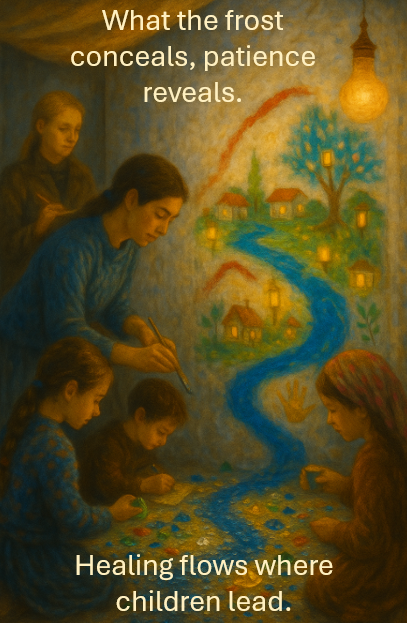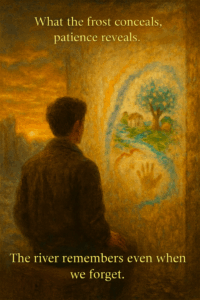
The thaw did not announce itself. It arrived as a softness in the air, a looseness to the snow at the eaves, a small wetness gathering under the window where frost had held its breath for days. Morning light entered less cautiously. The mural, half-veiled for a week, seemed to breathe.
Sofia came early with a thermos and a stack of papers. “A review board met last night,” she said, setting the papers down as if they might bruise. “Partial clearance. You may continue—under observation.” She glanced at Emil. “They want the children’s consent documented, and a local co-lead on every activity.” She tapped her chest. “That will be me.”
Aisha exhaled. Jaden grinned without teeth. Priya nodded, already building a folder called Co-Lead Protocols. Mina unthreaded the string around the quiet box and touched its lid like a blessing.
“Then we begin again,” Emil said, “by letting others begin.”
They did not unroll plans. They opened space.
Sofia gathered the children near the mural and asked, “What should stay? What should change? And who paints first?”
Hands shot up, then hesitated, then stayed, brave. Danylo pointed to the crimson line. “The path stays,” he said. “But it should find water.”
A little girl with the pomegranate scarf suggested a tree with rooms in its branches, “so the birds don’t have to choose which house is theirs.”
Another boy wanted windows, many of them, “so the siren has more places to escape.”
Aisha handed out sponges and wide brushes, then stepped back. Jaden rigged the canopy higher and hung muslin that drank the echo from the room. Priya arranged pigments and logged consent forms with quiet, careful hands. Mina placed the quiet box where the light was kindest and added a fresh slate: What did the frost keep safe?
Sofia dipped a brush and drew a small curve of blue beneath the path. “The river,” she said, “is yours.”
The children flooded the wall with gentleness. Water found its bed. Gold returned in small, patient lights—windows, lanterns, a sun hiding and then deciding to stay. The gray did not disappear; it settled into mist and stone, the honest ground beneath the color. Green crept along the edges of broken roofs, a rumor of vines.
Emil stood near the door watching something revise itself from within. The mural no longer looked like something the Circle had built. It looked like a place that remembered its own design and was letting them witness the recovery.
Taras brought in a shallow tray of broken glass sorted by shade—clear, smoke, cobalt. “From windows that didn’t survive,” he said. “Maybe they can become river.”
The children pressed the pieces into a line of glue along the painted water. Light scattered—blue like breath in winter, silver like the idea of a bell. The river shimmered as if the wall had learned to move without moving.
Near noon, an observer from the UN arrived—coat still damp with snow, clipboard at the ready. She watched quietly while Sofia co-led the session, occasionally asking from the sideline, “Who chose this color? Who suggested that shape?” The answers came from small voices and paint-wet fingers. At one point she lowered the clipboard and simply looked, as if something had outpaced her checkboxes and would not be hurried back inside them.
Later, during tea, Danylo approached Emil. “It feels different,” he said, almost apologetically.
“How?” Emil asked.
“Before, the wall was listening. Now it’s… remembering. Like when you hum a song and the words walk back on their own.”
Emil smiled. “Then we’re keeping the door open.”
That evening, the generator held steady. The room warmed. Snow slid from the window sash in a single long sigh. The river on the wall held a faint, living light—tile and pigment and handprint, current and memory.
Sofia packed the brushes last. “Tomorrow, the children lead without us,” she said. “You’ll be there—but behind.”
Emil nodded. He wrote it down: Behind is still within.
When the children left, he lingered by the mural. Where the crimson path entered the water, a tiny swirl had formed—unplanned, inevitable. He touched the ledger’s cover, then didn’t open it. For a moment he only listened, not for voices or numbers, but for the quiet pressure of continuity—the river beneath the ruins, moving where it had always intended to go.
That night he called Grandfather and spoke of blue glass and consent forms, of rivers made from shards. “We did less,” he confessed, “and more happened.”
Grandfather laughed softly. “You gave the current back to the riverbed.” A pause, then the old warmth: “You were never there to teach the flow, Emil—only to remind it of its course.”
Emil looked at the mural in the low light and felt the truth of it settle like a hand on the shoulder. Outside, a drip from the eaves counted time—melt, melt, melt.
Ledger Entry — The River Beneath the Ruins
Date: March 24, 2026
Symptom:
Partial clearance granted; activities resume under observation; local co-leadership established; youth initiative increases; mural reactivates through child-led choices.
Disease — The Four Absences (Local Context):
-
Absence 1 (Exclusion): Residual boundary between outsiders and locals; consent anxiety; formal oversight risks chilling spontaneous participation.
-
Absence 2 (Vengeance): Suspicion toward prior efforts persists in some adults; grievance narratives seek targets; fragile trust vulnerable to rumor.
-
Absence 3 (Dehumanization): Institutional view still frames healing as compliance; children’s agency at risk of being reduced to checkboxes.
-
Absence 4 (Unheard Cry): Some voices remain silent post-accusation; fear of visibility; grief not yet safe in public speech.
Investigator’s Response:
Shifted Circle from leadership to guardianship; installed local co-lead (Sofia); prioritized child-led design and consent visibility; maintained quiet box with new prompt (“What did the frost keep safe?”); reconfigured canopy to reduce echo; facilitated but did not direct mural additions; documented choices without attributing ownership unless volunteered.
Outcome:
Ownership transfers to community; mural evolves through youth decisions; participation increases; observers acknowledge local agency; symbolic river completed by children with salvaged glass; ambient trust rises; conflict incidents within shelter decrease informally (anecdotal reports).
Note:
Flow returns where control yields to participation.
What we keep alive is not the wall—but the water moving through it.


